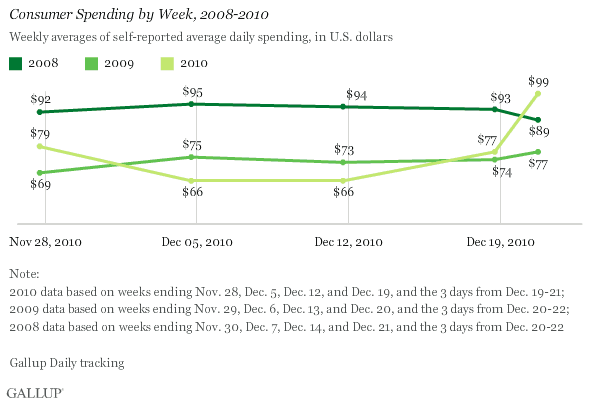PRINCETON, NJ -- Overall self-reported consumer spending in stores, restaurants, gas stations, and online jumped to an average of $99 per day from Dec. 19-21, suggesting there could be a last-minute spending surge during the week before Christmas.

Prior to this week, Gallup's self-reported spending measure found spending during recent weeks trailing that of a year ago. While spending did spurt during the week ending Dec. 19, consumers' self-reported outlays only matched those during the same week a year ago. In fact, even with what might be a last-minute spending spree, consumers' December 2010 expenditures are not likely to greatly exceed the $72 average spending of December 2009.
Commentary
Many Americans may be spending more at the last minute this year simply because of the calendar and the psychology surrounding it. This year's Saturday Christmas may be sneaking up on consumers because the combination of Thanksgiving coming late this year and the lack of a weekend just before Christmas may have made some consumers feel as though they had more time to make their holiday purchases than is really the case. Recognition that time is running out could create a somewhat greater-than-usual last-minute rush of Christmas spending this year.
Further, the last-minute extension of the Bush tax cuts may encourage upper-income consumers to spend more freely now than they did a few weeks ago. The recent highs on Wall Street and the related so-called "wealth effects" would suggest these consumers have the resources to spend if they feel secure about doing so.
Much of the Federal Reserve's efforts to boost the economy and the immediate-term benefits of the new tax-cut-extension legislation that has economists so optimistic about 2011 have yet to be realized by the average American. Still, increased optimism on Wall Street and in corporate America might help Americans who have jobs feel more secure that they will not lose them in 2011. In turn, this may help many middle- and lower-income Americans feel better about spending as Christmas approaches.
Most importantly, Gallup's most recent spending results suggest the nation's retailers could be in for some surprisingly good days during this last week before Christmas -- something everyone could use after a challenging year for consumers and retailers alike.
Gallup will report on self-reported consumer spending again next week to measure what happens during these last days of the Christmas season.
Gallup.com reports results from these indexes in daily, weekly, and monthly averages and in Gallup.com stories. Complete trend data are always available to view and export in the following charts:
Daily: Employment, Economic Confidence and Job Creation, Consumer Spending
Weekly: Employment, Economic Confidence, Job Creation, Consumer Spending
Read more about Gallup's economic measures.
View our economic release schedule.
Survey Methods
Results are based on telephone interviews conducted as part of Gallup Daily tracking during the weeks ending Nov. 28, Dec. 5, Dec. 12, and Dec. 19, 2010, with random samples of approximately 3,000 adults each week, aged 18 and older, living in all 50 U.S. states and the District of Columbia, selected using random-digit-dial sampling.
For results based on the total weekly samples of national adults, one can say with 95% confidence that the maximum margin of sampling error is ±3 percentage points.
Interviews are conducted with respondents on landline telephones and cellular phones, with interviews conducted in Spanish for respondents who are primarily Spanish-speaking. Each daily sample includes a minimum quota of 150 cell phone respondents and 850 landline respondents, with additional minimum quotas among landline respondents for gender within region. Landline respondents are chosen at random within each household on the basis of which member had the most recent birthday.
Samples are weighted by gender, age, race, Hispanic ethnicity, education, region, adults in the household, cell phone-only status, cell phone-mostly status, and phone lines. Demographic weighting targets are based on the March 2009 Current Population Survey figures for the aged 18 and older non-institutionalized population living in U.S. telephone households. All reported margins of sampling error include the computed design effects for weighting and sample design.
In addition to sampling error, question wording and practical difficulties in conducting surveys can introduce error or bias into the findings of public opinion polls.
For more details on Gallup's polling methodology, visit www.gallup.com.
